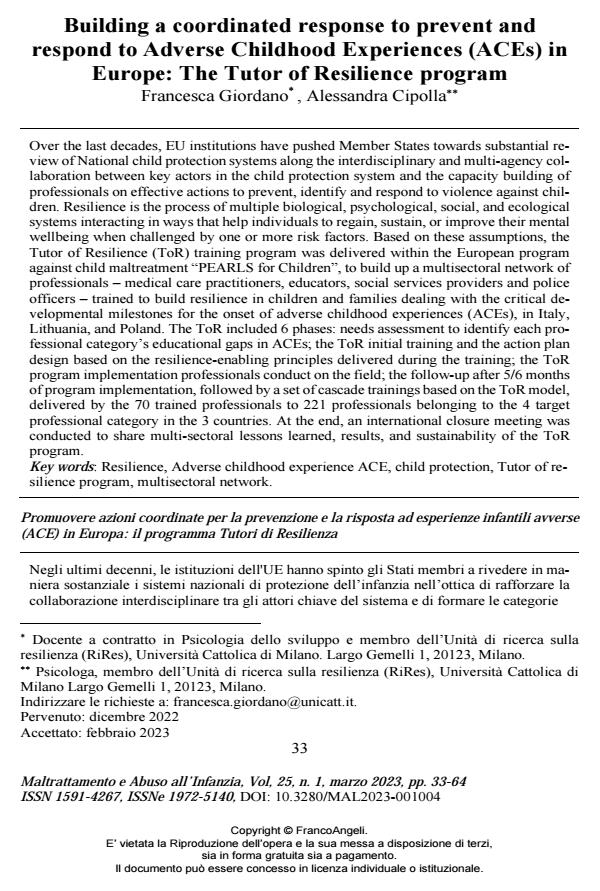Building a coordinated response to prevent and respond to Adverse Childhood Experiences (ACEs) in Europe: The Tutor of Resilience program
Titolo Rivista MALTRATTAMENTO E ABUSO ALL’INFANZIA
Autori/Curatori Francesca Giordano, Alessandra Cipolla
Anno di pubblicazione 2023 Fascicolo 2023/1
Lingua Inglese Numero pagine 32 P. 33-64 Dimensione file 321 KB
DOI 10.3280/MAL2023-001004
Il DOI è il codice a barre della proprietà intellettuale: per saperne di più
clicca qui
Qui sotto puoi vedere in anteprima la prima pagina di questo articolo.
Se questo articolo ti interessa, lo puoi acquistare (e scaricare in formato pdf) seguendo le facili indicazioni per acquistare il download credit. Acquista Download Credits per scaricare questo Articolo in formato PDF

FrancoAngeli è membro della Publishers International Linking Association, Inc (PILA)associazione indipendente e non profit per facilitare (attraverso i servizi tecnologici implementati da CrossRef.org) l’accesso degli studiosi ai contenuti digitali nelle pubblicazioni professionali e scientifiche
Over the last decades, EU institutions have pushed Member States towards substantial review of National child protection systems along the interdisciplinary and multi-agency collaboration between key actors in the child protection system and the capacity building of professionals on effective actions to prevent, identify and respond to violence against children. Resilience is the process of multiple biological, psychological, social, and ecological systems interacting in ways that help individuals to regain, sustain, or improve their mental wellbeing when challenged by one or more risk factors. Based on these assumptions, the Tutor of Resilience (ToR) training program was delivered within the European program against child maltreatment "PEARLS for Children", to build up a multisectoral network of professionals - medical care practitioners, educators, social services providers and police officers - trained to build resilience in children and families dealing with the critical developmental milestones for the onset of adverse childhood experiences (ACEs), in Italy, Lithuania, and Poland. The ToR included 6 phases: needs assessment to identify each professional category’s educational gaps in ACEs; the ToR initial training and the action plan design based on the resilience-enabling principles delivered during the training; the ToR program implementation professionals conduct on the field; the follow-up after 5/6 months of program implementation, followed by a set of cascade trainings based on the ToR model, delivered by the 70 trained professionals to 221 professionals belonging to the 4 target professional category in the 3 countries. At the end, an international closure meeting was conducted to share multi-sectoral lessons learned, results, and sustainability of the ToR program.
Negli ultimi decenni, le istituzioni dell'UE hanno spinto gli Stati membri a rivedere in ma-niera sostanziale i sistemi nazionali di protezione dell’infanzia nell’ottica di rafforzare la col-laborazione interdisciplinare tra gli attori chiave del sistema e di formare le categorie professionali coinvolte nella rete su strategie di azione per prevenire, identificare e rispondere alla violenza ai danni dell’infanzia. La resilienza è un processo che emerge dall’interazione di più sistemi biologici, psicologici, sociali ed ecologici che promuovono benessere e salute men-tale di minori e famiglie esposti a condizioni di rischio. Sulla base di questi presupposti, nell’ambito del progetto europeo a contrasto del maltrattamento infantile "PEARLS for Children" è stato condotto in Italia, Polonia e Lituania il programma formativo Tutori di Resilienza (ToR), al fine di creare una rete multisettoriale di professionisti composta da personale sanitario, educatori e insegnanti, operatori dei servizi sociali e agenti di polizia formati all’assunzione del ruolo di tutori di resilienza con minori e famiglie che affrontano le tappe di sviluppo criti-che per l’insorgenza di esperienze infantili avverse (ACE). ToR si è sviluppato in 6 fasi: l’analisi dei bisogni finalizzata a identificare conoscenze, competenze e gap formativi di cia-scuna categoria professionale in materia di ACE, un ciclo formativo basato sul modello ToR e la progettazione di un piano d’azione ispirato ai principi di resilienza P.E.A.R.L.S. alla base del modello, l’implementazione del programma ToR sul campo ad opera dei professionisti formati, il follow-up a seguito di 5/6 mesi di implementazione del programma, seguito da una serie di formazioni a cascata basate sul modello ToR erogate dai 70 professionisti formati a 221 pro-fessionisti appartenenti alle 4 categorie professionali target di progetto nei 3 Paesi. Al termine del progetto, è stato condotto un incontro finale di chiusura per condividere lessons learned multisettoriali, risultati e sostenibilità del programma Tutori di Resilienza.
Parole chiave:resilienza, ACE, tutela all’infanzia, il programma Tutori di Resilienza, rete in-terdisciplinare.
Francesca Giordano, Alessandra Cipolla, Building a coordinated response to prevent and respond to Adverse Childhood Experiences (ACEs) in Europe: The Tutor of Resilience program in "MALTRATTAMENTO E ABUSO ALL’INFANZIA" 1/2023, pp 33-64, DOI: 10.3280/MAL2023-001004